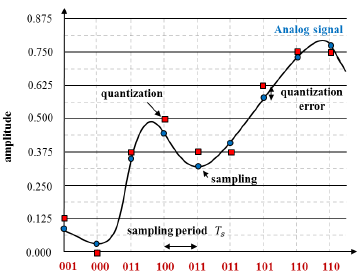Analog to Digital Conversion: Technologies used to convert analog signal to digital signal
PCM (Pulse Code Modulation)
The most basic form of ADC.
Simply, it takes four steps of Sampling - Quantization - Digitization - Encoding.
Sampling: Takes samples of analog signal at regular interval.
Quantization: Process that truncate each sampled value as the ones that computer can represent.
Digitaization: Process that represent quantized valuse as digital binary

DPCM (Differential Pulse Code Moudulation)
Uses difference between predicted value of the analog signal and sampled data right before the signal.
So, DPCM requires less capacity than PCM.
| Sample | 1 | 2 | 3 | 4 | 5 | 6 | 7 |
| Bit Depth | 10 | 11 | 15 | 10 | 8 | 5 | 10 |
| DPCM (Difference) |
10 | +1 | +4 | -5 | -2 | -3 | +5 |
But if the difference is bigger than DPCM's capacity, it can't represent the original analog signal precisely (which is called slope overload)
ADPCM (Adaptive Differential Pulse Code Moudulation)
To solve the problems of DPCM (like slope overload), ADPCM is developed.
ADPCM uses difference signal like DPCM does, but apply 15 level adaptive quantizer to the signal and get 4bit value so that it decrease the possibility of slope overload.
DM (Delta Modulation)
The simplist form of DPCM.
The size of difference signal is only 1bit.
ADM (Adaptive Delta Modulation)
Advanced version of DM.
Uses adaptive quantizer.
DM and ADM are actually not used as they are inaccurate.
'기타' 카테고리의 다른 글
| Stackoverflow는 사랑입니다. (0) | 2022.05.09 |
|---|---|
| Audio Format - CD/SACD/DVD-audio/XRCD/HDCD (0) | 2021.04.15 |
